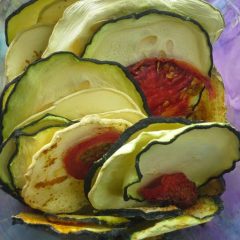
Like so many who survived The Great Depression, my mother’s mother was a big canner. I never knew Mary Scalbom Nicholson in those days – by the time we grandkids were snacking round her kitchen table, or massed around the big green picnic table in the backyard, Grama had given up canning tomatoes and peaches. She still made her famous sturdy brown bread (bacon fat was the trademark ingredient), and beef vegetable soup though. I can remember the taste of each. I loved Grama’s bread, but it workd out best toasted. Woe to to the eater of a sturdy brown bread pb& j; best dunk it in the soup before you bite.
I have a theory that interest in food preservation skips generations. Adult kids of big canners that I know aren’t into it . My mom had no good memories of the process. She could still see Grama sweating over a steaming kettle in August – for something you could buy for ten cents at the grocery store! “Tomatoes are cheap!”she exclaimed to me. Marianne loved the art world, and she saw the two as competitive and mutually exclusive.
But from childhood I had a strong interest in “living off the land” (I loved art too). When Mom told me how Grama would get permission to pick all the wormy apples from a farmer’s tree, then spend hours and hours cutting all the wormy spots out, to make applesauce, I thought Ah! How clever! The difference in flavor between homemade and commercial applesauce is particularly noticeable. But Marianne may have known at some level she had only a short number of years on earth and she didn’t want to be remembered for applesauce and stewed tomatoes. She did make fantastic, towering lemon meringue pies – works of art! – and yummy soup.
I will be surprised if any of our six highly artistic children wind up canning, freezing, or dehydrating. I’m waiting to share all that I’ve learned about it with the grandkids.
